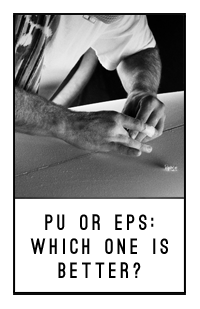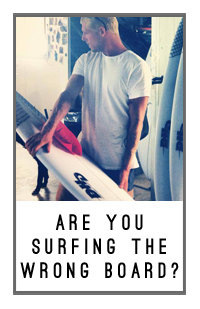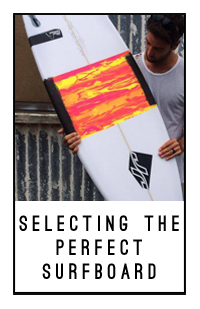Choosing the ideal construction
We have already had a look at the basic breakdown in the two most commonly used options widely available today, and why one might seem a better fit for you than another
PU/PE vs EPS/Epoxy.
Now we will have a look (in no particular order) at a few of the different construction methods and what they mean to your boards characteristics.
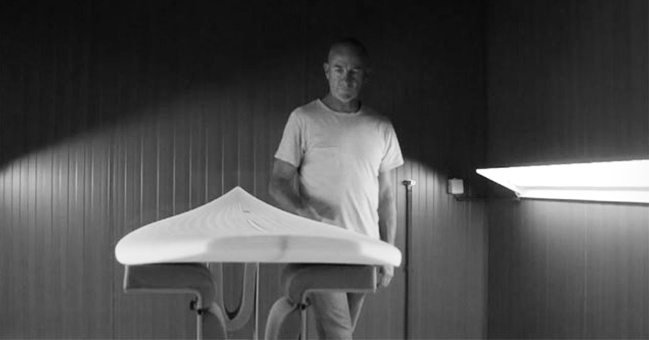 In the DHD Surfboards factory with shaper Darren Handley.
In the DHD Surfboards factory with shaper Darren Handley.
Future Flex
Future Flex is essentially the use of carbon fibre parabolic reinforced rails, which means carbon wraps on the rails around the whole board. This is combined with a high density EPS stringer-less blank and glassed with a very high quality Epoxy resin and quad-axial fibreglass cloth.
The combination of the unique materials used in Future Flex results in a very lively board with a ton of projection.
The drive and speed in the board is a result of the board being able to flex and spring back, while minimising the twist that can happen, storing and releasing all of the energy through your turns.
It does have a different feel underfoot without having the rigged stringer there, but as you get used to it you learn to feel through the board really well. The
Haydenshapes Hypto Krypto is often ordered in this construction.
Patented Methods:
Hydroflex
Hydroflex 3D Glassing technology, takes bonding the fibreglass and resin with the foam to a whole new level.
With this patented technology, the fibreglass and resin laminate are anchored into the foam core. This is different to normal when you see the laminate simply bonded to the surface of the foam, and the result is a board with a very lively and responsive high-performance feel.
All the Hydroflex boards use high quality epoxy resin as it is stronger and more flexible than Polyester resin ensuring you get a better “spring back” effect and making it less prone to cracking.
By basically eliminating the possibility of de-lamination over time with the “skin” anchored into the foam, these boards keep youthful way longer than other methods.
Carbon Wrap Technology
Another Technology rightfully patented is Carbon Wrap Technology exclusive to
DMS Surfboards and
Lost Surfboards in Australia.
This technology uses a stringer-less blank and the strategic placing of carbon bands in and around the board to give the board a lot of "pop".
The use of carbon strips flaring out towards the rails results in contortion twist creating superior flex which results in more drive. This added drive with a unique tail flex pattern gives you a super lively “next level” feel to these boards.
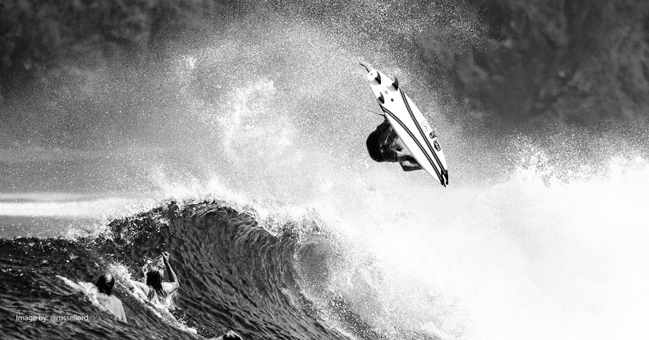 Getting some air with a DMS Surfboards model in Carbon Wrap technology.
Getting some air with a DMS Surfboards model in Carbon Wrap technology.
EpoxiCore Construction
"EpoxiCore" Construction has been brought out by
DHD Surfboards in 2016 and is already being heralded as a revolution in surfboard design. The
Epoxi Core Construction uses both a traditional PU Blank with an Epoxy Blank combined into one blank to optimise the best bits of both constructions.
The epoxy mid section of the board creates a lighter more 'whippy' feel while the PU outline gives you the performancey feel of the traditional PU construction.

USC Construction
“Ultra Stringerless Carbon”, which may seem similar to other parabolic carbon boards, sets it self apart in it’s unique blend of materials.
This construction uses a stringer-less PU blank instead of EPS, and a unique way in how the carbon is wrapped around the perimeter of the board. The carbon on these boards will generally be laid on the deck around the rails, and wrap just to the bottom of the rail, not under the board.
These also make use of a high quality “bio” polyester resin which is unique in itself.
The PU blank gives you a familiar feel while the parabolic carbon adds a ton of speed, drive and flex. The “bio” polyester resin lowers the carbon footprint of each board yet keeps a traditional feel allowing you to jump on one and instantly feel comfortable on it.
SUPERflex
An exclusive design by
SUPERbrand, SUPERflex construction utilizes a high quality stinger-less blank, combined with a carbon fiber net along the whole bottom of the board and carbon fiber reinforced rails.
A unique and lively feel, the SUPERflex tech has a unique flex pattern with quick release for high performance surfing.
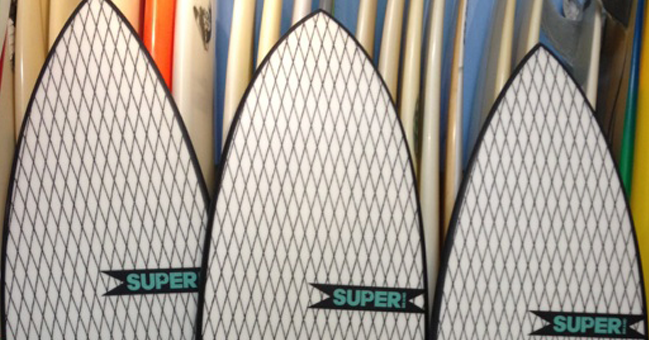 The Superbrand, Superflex technology.
The Superbrand, Superflex technology.
Varial Foam
Varial Foam is fairly new to the surf industry, but the same technology has been used in aerospace for a long time. The strength of the foam allows you to eliminate a stringer or any sort of reinforcement other than glassing as standard.
This unique foam has a constant density throughout and can be made using either Polyester or Epoxy resins. It is lightweight and due to the rigidity and spring back of the foam naturally, gives you flex properties like you have never felt before.
The beautiful thing about this foam is you can combine it with other construction methods and blend your own high performance stick. Treat it as another option besides PU or EPS foam.
General Materials:
The methods above have a patent that extends just using the individual materials themselves, so that leaves a lot of experimentation to be found through test combinations of different materials.
Carbon Tape
Carbon Tape is useful in many ways.
Laying it out down the center of the board (either top, bottom or both) can either act as your stinger when using a stringer-less, or help to stiffen up a board that might be too flexible for it’s intended purpose. Or to simply attempt to add strength to a board to make it long lasting.
Many times you will find strips or patches of this carbon tape on top of the board near the rails at the tail for added reinforcement against pushing hard on your toes or heels through turns. Or, as seen in the above examples, around the perimeter of the board in some way, wrapped around the board in strategic ways, the possibilities are almost endless.
Vector Net
Vector Net is a carbon fiber net woven to resemble diamond like patterns. This is a great tool to offer reinforcement while drastically reducing weight even more.
Again, this can be used to alter flex patterns, or simply to add reinforced structure to board for people who either tend to break boards or are heavy footed and often crush their decks.
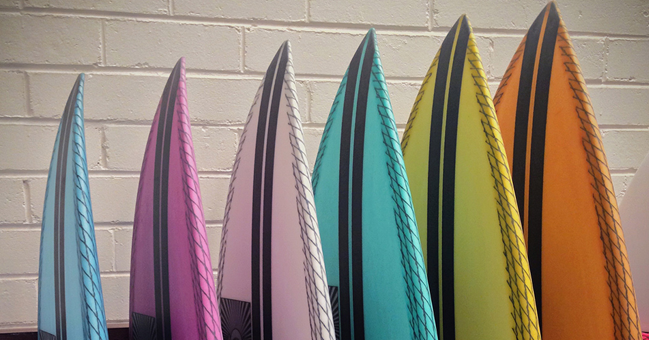 A few Eye Symmetry board models that make use of Magic Fibre construction. Carbon strips underneath and a net on the deck.
A few Eye Symmetry board models that make use of Magic Fibre construction. Carbon strips underneath and a net on the deck.
Bamboo
Bamboo works as a great alternative to using carbon fiber especially if you are trying to create a more sustainable surfboard and lower the carbon footprint of your surfboard. Usually found over EPS, as a reinforcing skin which is then glassed over lightly.
Not only does this add strength to the board, it looks great for a totally unique board, and it reduces the amount of fiberglass and resin needed adding to the sustainability of the board.
Cork
Cork can be used for some unique attribute. Normally found with EPS and Epoxy applications, the cork helps to dampen the “twitchy” feeling you can get from an epoxy board.
There is also no need for wax when surfing a board with a cork deck. The cork is normally vacuum bagged to the board after the board has been glassed, leaving the cork surface exposed.
Give a nice feel to the board underfoot and through performance, and you can avoid getting wax all over the seats of your car.
Straight Up Stringer-less
You can get creative and just go straight up stringer-less if you like.
Using this as an option for certain boards can be great as it can really allow them to flow and ride “with” the wave instead of riding "on" the wave.
You may find this on retro outlined fish to help bend and project them around on those mushy playful days. They even work well on some longboards, giving you a totally unique flex when surfing from different parts of the board (nose, mid, off the tail).
Summary:
This is by no means a way of telling you the only options out there. These are all options that can be found with certain brands or surfboard models found on
Boardcave.
But there are many more
patented surfboard construction technologies, or certain methods combining certain materials though many other brands who we may see in the future.
The idea here is to try to give you a better understanding of why some of the constructions work the way they do, and what common place materials are being used in many of today's boards.
Like everything else surfboard related, there are endless combinations of designs, materials, constructions and methods that can be tested and still have yet to be found.
That’s the best part about surfboards and surfing, both will continue to evolve!
Looking for more articles? Check out our popular articles below:
